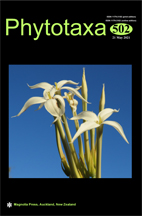Abstract
Thalictrum minshanicum and T. pseudoramosum (Ranunculaceae), two new species from southern Gansu and northwestern Sichuan, China, are illustrated and described. Thalictrum minshanicum is somewhat similar to T. brevisericeum in habit and in having puberulent stem and leaves, but differs by having conspicuously 3-lobate (vs. slightly 3-lobate) leaflets, glabrous (vs. puberulent abaxially) sepals, longer (ca. 7 mm vs. ca. 4 mm) and clavate (vs. oblanceolate-linear) filaments, conspicuous (vs. inconspicuous) stigmas, and persistent styles slightly recurved (vs. circinate) at apex. Thalictrum pseudoramosum is closely similar to T. ramosum in habit and in having slightly recurved styles at apex, but differs by having subcoriaceous (vs. herbaceous) leaflets, more numerous stamens (40‒60 vs. 16‒24), and elliptic-fusiform (vs. lanceolate-fusiform) achenes.

